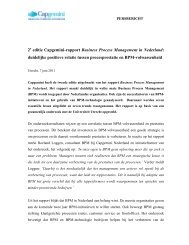IT transformations - Capgemini Consulting Nederland
IT transformations - Capgemini Consulting Nederland
IT transformations - Capgemini Consulting Nederland
You also want an ePaper? Increase the reach of your titles
YUMPU automatically turns print PDFs into web optimized ePapers that Google loves.
If existing frameworks are not always<br />
useful, what is? The answer lies in<br />
building new concepts that are more<br />
attuned to a world driven by alliances<br />
and the aim to reshape sectors. Today,<br />
effective organizations leverage far<br />
more than their own actions in order<br />
to both create and capture value. They<br />
shape the rules and roles of their<br />
sector, aiming to become a bottleneck<br />
and “rule without owning” – that<br />
is, leveraging the skills and energy<br />
of others. Companies sticking to<br />
traditional sector definitions often fail<br />
to see how profits migrate from their<br />
own, narrow part of the industry to<br />
other parts of the sector as the result<br />
of changes in the “rules of the game”<br />
around them. Without a change in<br />
worldview, they might find that their<br />
position becomes untenable 2 .<br />
For instance, the snapshots of market<br />
capitalization in the computing<br />
sector (see Figure 1) show how value<br />
shifted in the sector from computer<br />
makers such as Apple and IBM to<br />
GUI/OS 3 manufacturers such as<br />
Microsoft and CPU 4 makers such<br />
as Intel. More recently, power has<br />
migrated again, to ISPs 5 and search<br />
engines such as Google. Computer<br />
makers didn’t realize how the<br />
“industry architecture” around<br />
them had changed until it was too<br />
late. By looking only at their direct<br />
competitors they lost the opportunity<br />
to create more value and strengthen<br />
their own position, allowing<br />
previously marginal participants<br />
like Microsoft and Intel to occupy<br />
key positions in the industry and to<br />
change the nature of the sector to<br />
their advantage.<br />
Successful companies aim to impose<br />
their own vision on the architecture<br />
of their industry. Competition today<br />
is about whose “vision” will succeed,<br />
and who will create and hang onto<br />
the bottleneck. Google transformed<br />
Internet search, web advertising,<br />
Figure 1: Market Capitalizations, Computing Sector, 1992–2005<br />
Industry Segments<br />
Computer Systems and<br />
Peripherals<br />
Software Publishing<br />
Semi Conductor<br />
Electronic Component<br />
Manufacturing<br />
Computer System<br />
Design<br />
Internet Service<br />
Providers<br />
Web Services<br />
1992 1997 2005<br />
The size of the pie charts represents the market capitalization of the industry segment<br />
IBM<br />
Hitachi Limited - ADR<br />
Hewlett Packard<br />
Toshiba Corp<br />
NEC Corp - ADR<br />
Digital Equipment<br />
Microsoft Corp<br />
Novell Inc<br />
Apple Computer<br />
Oracle Corp<br />
Intel Corp<br />
Compaq Computers<br />
Sun Microsystem<br />
Cisco Systems<br />
Dell Inc<br />
Fujitsu Ltd - ADR<br />
Ebay Inc<br />
Yahoo Inc<br />
Google Inc<br />
Texas Instrument<br />
Taiwan Semicond<br />
SAP AG-ADR<br />
Others<br />
Source: From the Structure of the Value Chain to the Strategic Dynamics of Industry Sectors, Michael G. Jacobides,<br />
Carliss Y. Baldwin & Reza Dijaji, 2007<br />
and the means through which<br />
digital content can be monetized.<br />
Now, it is trying to do the same<br />
in mobile telephony. By providing<br />
research and development and a<br />
platform (Android), it aspires to<br />
obtain de facto control of browsing<br />
and search in mobile devices. While<br />
Google encourages competition<br />
in complementary segments like<br />
handsets or programming and<br />
applications, it maintains its grip<br />
on the Android browsing and<br />
search experience. Compared with<br />
the current model, where telecom<br />
providers control what happens in<br />
the handset, it’s clear why Google is<br />
keen on this version of the brave new<br />
world.<br />
Companies can add value by<br />
reorganizing existing products and<br />
ideas in a sector as long as they hold a<br />
powerful position in the value chain.<br />
Or they can unleash value by virtue<br />
of a new product or service-delivery<br />
model that integrates the value added<br />
by an array of participants. Crucially,<br />
companies do not need to own the<br />
key resources they rely on, as existing<br />
theory suggests. They need to ensure<br />
that the parts of the value chain they<br />
2 Michael G. Jacobides, Thorbjorn Knudsen and Mie Augier, Benefiting from Innovation: Value Creation, Value Appropriation<br />
and the Role of Industry Architectures, Research Policy, pp. 1200-21, Vol. 35, 2006 and ibid, Who does What and Who<br />
takes What: Benefiting from Innovation, AIM Management Briefing, December 2006.<br />
3 Graphical User Interface/Operating System.<br />
4 Central Processing Unit.<br />
5 Internet Service Provider.<br />
“<br />
Companies<br />
sticking to<br />
traditional<br />
sector<br />
definitions<br />
often fail to<br />
see how profits<br />
migrate from<br />
their own,<br />
narrow part of<br />
the industry to<br />
other parts of<br />
the sector<br />
”<br />
85
















